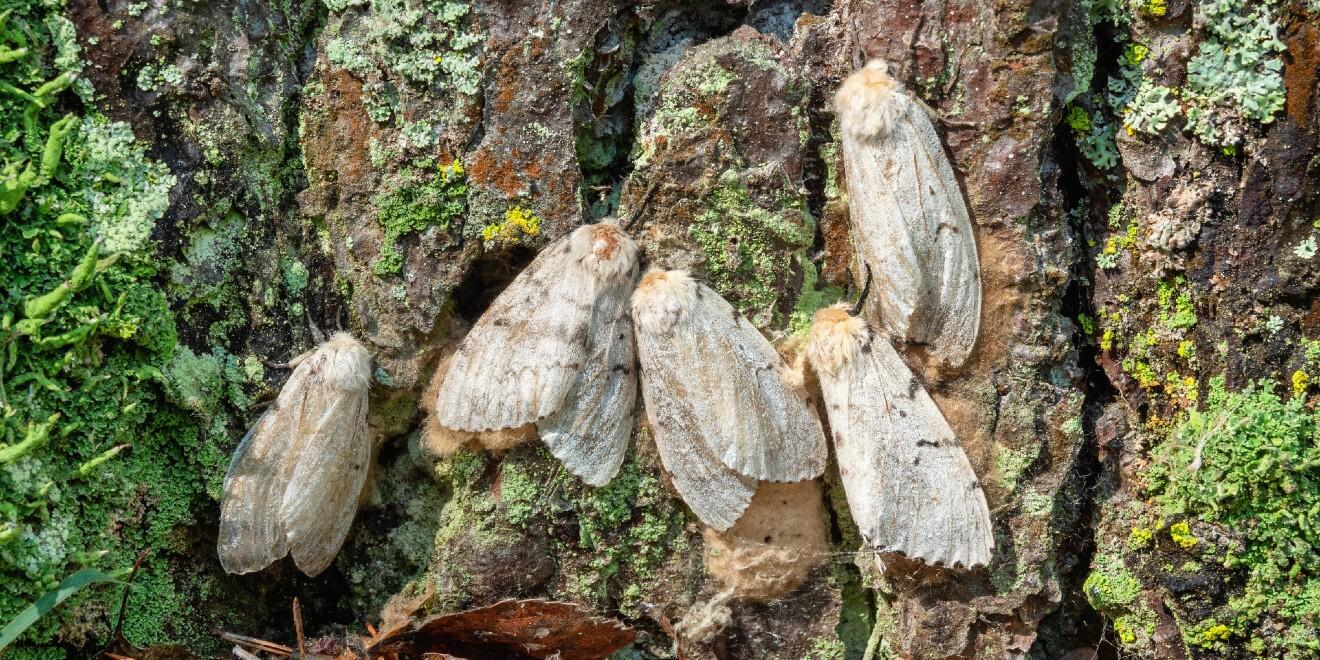How to Manage a Spongy Moth Infestation
Posted by Mosquito Squad
June 14, 2024
How to Get Rid of Spongy Moths + Tips to Keep Them Away!
Imagine waking up to find your property is far less green and vibrant than it was the night before, your beloved trees stripped of their leaves. This is the kind of devastating work that can be done by the spongy moth, an invasive pest that poses a significant threat to hardwood trees, especially in areas throughout the northeastern United States.
Previously known as the gypsy moth, the spongy moth does the most damage when it’s in the caterpillar or larvae stage, which is when they feed on tree foliage.
If you’re concerned about a potential spongy moth outbreak or already have one in your yard, read on to explore insights about infestations and practical tips to get rid of spongy moths.
The first step to managing spongy moths is understanding what they look like and their behaviors.
What Does a Spongy Moth Look Like?
Identifying spongy moths early is key to managing or preventing damage to your property’s trees. Here are a few key characteristics of spongy moths at each stage:
Spongy Moth Eggs
If you inspect the trunk and branches of your trees and find dark brown eggs in masses of 100 to 600, you might have a spongy moth infestation. Homeowners often find these eggs wrapped in a light, hair-like covering on the base of tree trunks and the side or underside of outdoor surfaces. While eggs are typically on a tree to ensure they are close to a food source when they hatch, they can also be found on many surfaces including firewood, lawn furniture, toys, and other hidden places. Be sure to check hard surfaces for eggs before moving them throughout your yard. This stage lasts around 40 days.
Spongy Moth Caterpillars
These are typically hairy and easy to spot due to their distinctive pattern of blue and red dots along their backs. The larvae grow to be about 2.5 inches long, and their bodies are covered with bristle-like hairs, which can cause skin irritation upon contact. They are often in groups around trees and stay in this stage for about a month before resting in their pupal cases and becoming moths. The caterpillar stage is the only time when a spongy moth feeds, meaning this stage is the most devastating to the trees and foliage in your yard. Caterpillars feed on leaves and travel up tree trunks and branches on their hunt for healthy leaves.
Adult Male Spongy Moths
Noticeably smaller and more agile than females, the males have a wingspan of about 1.5 inches. They are brownish and have feathery antennae. Their flight during the mating season makes them more visible than females.
Adult Female Spongy Moths
Significantly larger than their male counterparts, females boast a wingspan of about 2 inches. They’re predominantly white with distinctive dark brown markings across their wings. Unlike males, females are flightless and can often be found near the base of trees laying eggs.
Both males and females can vary slightly in color and size depending on their environment and diet, but these general descriptions should aid in early detection. All adult spongy moths only live for a few days, just long enough to mate and lay eggs.
What Do Spongy Moths Eat?
Unfortunately, spongy moth caterpillars are not picky eaters. While they prefer to feed on oak trees, spongy moth caterpillars are happy to aggressively consume the leaves of more than 300 tree and shrub species from May to July.
What trees do spongy moths eat most often?
- Oaks
- Willows
- Birches
- Poplars
- Aspens
- Crabapples
While these are some of their favorite trees to eat, spongy moths have also been known to consume spruce, pine, and hemlock needles during heavy infestations!
Their insatiable appetite for so many different species of trees mean the spongy moths thrive in many environments, making early identification and control crucial.
While spongy moths only eat in the caterpillar or larval stages because adult moths only live for a few days, adult moths should still be considered a threat, as they quickly lay eggs that lead to further devastation.
Spongy Moth Damage: What to Expect
These pests can be incredibly destructive, especially in the larvae stage. When caterpillars devour leaves, they cause trees to lose their photosynthesis ability. Without the ability to photosynthesize, the affected trees are unable to produce the resources required for survival. As a result, defoliated trees susceptible to other pests and diseases. While healthy trees that have lost many of their leaves can often survive, trees stressed by extreme weather conditions and other pests often cannot survive repeated defoliation.
Another concern for home and business owners is how spongy moth droppings can stain the home or business building exterior.
Without intervention, invasive spongy moths can do more than create an eyesore on your property – they can lead to consequential ecological and, for orchard owners, agricultural problems.
Related Invasive Insect Blog: Get to Know the Invasive Spotted Lanternfly
5 Tips for Spongy Moth Control
Managing a spongy moth infestation requires a proactive approach. Here are five tips to guide you:
- Identify, remove, and destroy egg masses – If you find spongy moth egg masses on tree or outdoor surfaces, wear protective gloves and scrape them off with a paint scraper or knife into a bucket. Then, soak the eggs in a soap-water solution for at least two days before discarding them so you can be sure they won’t survive and hatch in the spring. This method can also be used to suffocate caterpillars and prevent them from further damaging your trees. However, it can be trickier to remove the pest at this stage.
- Spray tree trunks – Water mixed with dish soap and vinegar (the smell further deters the invasive pests) can be sprayed on trees to help prevent moths and caterpillars. Be sure to spray at least as high as any spongy moths already on the tree or higher because, after hatching, caterpillars make their way up the tree to find leaves for nutrients.
- Wrap trees in burlap – Wrap a piece of burlap around your tree trunks above any egg masses to trap caterpillars as they travel up the tree after they hatch and begin to look for foliage. Use yarn or safety wire to tie the burlap around the tree and then fold the burlap in half to ensure caterpillars cannot get past. Once trapped, you can remove the burlap full of caterpillars and soak it in soapy water for two days before discarding.
- Call for professional spongy moth control – Rely on a professional team to perform spongy moth control measures for peace of mind. Mosquito Squad’s barrier treatment spray not only kills pests on contact but continues to help deter them for up to 21 days following treatment. Our professionals will assess areas in your yard that are already infested along with potential areas where spongy moths may go next to ensure your entire property is protected.
- Encourage natural predators – Some birds, mice, and some insects may help control spongy moth populations naturally. Common predators include blue jays, orioles, chickadees, and Trichogramma wasps that lay their eggs inside spongy moth eggs. Create a welcoming habitat for predators by planting fruiting and flowering plants like holly and sunflowers or adding a bird feeder to your yard.
Don't Let a Spongy Moth Infestation Wreak Havoc on Your Property
Managing a spongy moth infestation is about understanding the enemy and taking timely, effective action. While complete eradication might not be possible, controlling the population and limiting damage to your trees is certainly within reach.
If you need help protecting your property from the invasive spongy moth, Mosquito Squad is here!
We recommend our Squad Invader Guard pest package service if you’re currently dealing with a spongy moth infestation. This service was created to target already present invasive pests and protect other areas on your property where they’re likely to cause damage. Request a quote online or call our team at (877) 332-2239 to get started.
